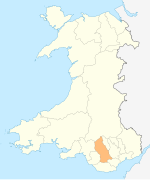River Cynon
| River Cynon | |
|---|---|
 River Cynon from Abercynon bridge | |
| Native name | Afon Cynon (Welsh) |
| Location | |
| Country | Wales |
| Historic county | Glamorgan |
| Unitary Authority | Rhondda Cynon Taf |
| Settlements | Aberdare, Mountain Ash, Abercynon |
The River Cynon (Welsh: Afon Cynon) in South Wales is a main tributary of the Taff. Its source is the rising of Llygad Cynon (OS grid ref SN 95240 07740) at 219 m (719 ft) above sea level at Penderyn, Rhondda Cynon Taf and flows roughly southeast, into the Taff at Abercynon in the same district.[1] The water emerging at Llygad Cynon has been traced back to the sink of the Nant Cadlan at Ogof Fawr.[2]
Course[edit]
The Nant Cadlan and its tributary the Ceunant Du rise on the slopes of Cefn Cadlan to the northeast of Penderyn flowing initially southeast and then south on the east side of the village to the point where the Cynon arises, adding to the flow emerging from the rising. The waters of the Nant y Bwllfa enter the Cynon as a left-bank tributary between Penderyn and Hirwaun. Downstream, the course of the river has been altered at the former Hirwaun Ironworks. The combined flow of the Nant Hir and Nant Melyn enter the river to the north of Penywaun and that of the Nant y Gwyddel to the east of Penywaun. The Dare River enters as a right bank tributary at Aberdare and the Aman River at Aberaman. The final tributary of any size is the Nant Pennar which enters on the Cynon's left bank at Mountain Ash (Welsh: Aberpennar).[3][4]
Hydronymy[edit]
The name is recorded as Canan in 1253 and Kenon in 1536-9, with the final vowel pronounced with an ə sound.[5] While Thomas Morgan stated that the name was a compound of the elements "cyn" (meaning chief) and "ain" (water or brook), giving a meaning of the "chief brook",[6] modern writers more commonly state that the river derives from a personal name, Cynan or Cynon.[7] This is also the preferred derivation for the Ffrwd Cynon, a tributary of the Teifi. However, no eponym has been identified for either river.[8]
Related terms[edit]
Together with two neighbouring rivers, it gives its name to a local authority, with unitary status, Rhondda Cynon Taf.
The valley, broadly defined as the bulk of the drainage basin is detailed in Cynon Valley.
References[edit]
- ^ "Hydrogeology of Wales: Carboniferous aquifers - the Carboniferous Limestone aquifer". Earthwise. British Geological Survey. Retrieved 13 December 2020.
- ^ "Llygad Cynon". Cambrian Cave Registry. Cambrian Caving Council. Retrieved 13 December 2020.
- ^ Explorer map OL12 Brecon Beacons National Park (A2 ed.). Southampton: Ordnance Survey. 2009. ISBN 9780319240533.
- ^ Sheet 166, Rhondda and Merthyr Tydfil (A2 ed.). Southampton: Ordnance Survey. 2008. ISBN 9780319240304.
- ^ Owen, Richard, Hywel Wyn, Morgan (2022). Dictionary of the Place-Names of Wales. Y Lolfa. p. 3. ISBN 9781800992399.
{{cite book}}: CS1 maint: multiple names: authors list (link) - ^ Morgan, Thomas (1887). Handbook of the Origin of Place-names in Wales and Monmouthshire.
- ^ Mills, Anthony David (2011). A dictionary of British place-names (1st rev ed.). Oxford New York: Oxford University Press. p. 144. ISBN 9780199609086.
- ^ Lewis, Samuel (1849). A Topographical Dictionary of Wales. London. pp. 238–241. Retrieved 10 December 2023.
51°38′44″N 3°19′34″W / 51.6455458°N 3.3260799°W

